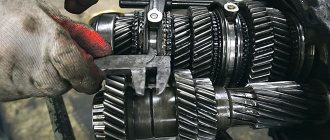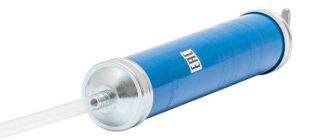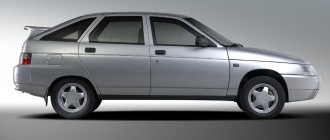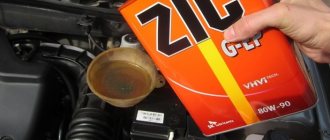As you know, DSG is a robotic preselective gearbox, which is actively installed on a large number of different brands and models of VAG cars. This transmission is a separate type of gearbox that combines elements of an automatic transmission and a manual transmission.
The manufacturer itself states that the DSG robot is highly reliable and is an advantageous solution compared to traditional hydromechanical automatic transmissions or CVT variators. One way or another, it is important to understand that this box requires regular and high-quality maintenance, taking into account a number of features of its design.
Such maintenance should be understood, first of all, as changing the oil in the DSG, as well as the oil filter of the DSG box. Next, we will talk about when the oil in the DSG needs to be changed, how the oil in the DSG box is changed, and also what to pay attention to during this procedure.
What is a robotic transmission
The basis of a manual transmission is a conventional manual transmission, the speeds of which are switched not by the driver, but by an electronic control unit (ECU) coupled with actuators, electrical or hydraulic actuators, including mechatronics. The ECU evaluates the speed parameters of the machine and the load on the engine, then determines the optimal gear for this mode. If another speed is enabled, the control unit performs the following actions:
- disengages the clutch;
- turns on the required gear;
- connects the engine to the transmission.
This happens every time the currently engaged gear does not match the speed and load on the vehicle.
Model range of cars with DSG 6 gearboxes
So, DSG 6 – which models can this automatic transmission be installed on?
As already mentioned, a number of cars produced by the VAG group are equipped with this box. The heavy (93 kilograms of weight) DSG 6 provides transmitted thrust up to 325 Newtons, which is suitable for medium and high-power engines - from popular 1.4-liter engines and up to 140 horsepower, to 250-horsepower 3.2-liter V-6 engines. The engineers decided that low-power cars would be equipped with a less heavy (70 kg) and less high-torque model of the DSG-7 gearbox.
The gearbox in question is actively installed on Volkswagen :
- Sharan;
- Tiguan;
- Golf;
- Passat;
- Touran, etc.
For some Audi models:
- TT;
- A3;
- Q3.
Skoda:
- Octavia;
- Superb.
Seat:
- Alhambra;
- Toledo.
What is the difference between manual transmission and DSG-7
Robotic transmissions based on conventional manual transmissions are characterized by slow operation of the actuators, so a car with a conventional manual transmission starts with a delay and also “stumbles” when shifting gears up or down. A solution to the problem was found by specialists developing units for racing cars. They used an idea proposed back in the thirties of the last century by the French inventor Adolphe Kegresse.
The essence of the idea is to use twin gearboxes, one part of which operates at even speeds, the other at odd ones. When the driver realizes that he needs to change to another speed, he engages the required gear in advance, and at the moment of switching, he breaks the clutch of one part of the box with the engine and activates the clutch of the other. He also suggested the name of the new transmission - Direkt Schalt Getriebe, that is, “direct gearbox” or DSG.
DSG-7 oil change
At the time of its appearance, this idea turned out to be too revolutionary, and its implementation led to the complication of the design of the machine, which means it increased its cost and made it less in demand on the market. With the development of microelectronics, this concept was adopted by specialists developing units for racing cars. They combined a conventional mechanical gear reducer with an electric and hydraulic drive, thanks to which the time spent on each operation was reduced to acceptable values.
The abbreviation DSG-7 means that it is a pre-selective seven-speed transmission, so DSG-6 means the same unit, but with six gears. In addition to this designation, each manufacturer comes up with its own name. For example, the Renault concern calls units of this type the abbreviation EDC, and the Mercedes company gave them the name Speedshift DCT.
How to prepare a car for work?
Before starting the replacement, it is important to warm up the transmission thoroughly. To do this, it is better to make a preliminary trip, during which the oil inside will become warm. In this state, the liquid becomes more fluid and will flow much more easily and quickly from the shafts and gears located inside during draining.
If in the summer you can do without a long preheating procedure, then in the winter it will be difficult to drain the lubricant from the gearbox of a car that has been standing in the cold for even less than an hour. Warming up can be accelerated by frequent starts and stops; this mode loads the transmission of this type most heavily and quickly.
What types of DSG-7 are there?
There are 2 types of gearbox, which differ only in the design of the clutch, which can be wet or dry.
The wet clutch is taken from traditional hydraulic automatics, and is a set of friction and steel discs that are pressed against each other by a hydraulic cylinder, and all parts are in an oil bath. The dry clutch is completely taken from the manual transmission, but instead of the driver’s foot, the electric drive acts on the fork.
Mechatronic, that is, the internal mechanism that controls the gear shift forks and executes ECU commands, works the same for all types of robotic transmissions. But for each gearbox they develop their own version of this unit, so mechatronics is not always suitable even for the same gearbox, but released several months or years earlier.
Clutch
This knot is quite complex. The DSG robotic gearbox uses two clutches and a dual-mass flywheel. The latter suffers wear during large torsional vibrations. This occurs due to sudden starts and slipping of the clutch disc.
As noted in reviews, DSG boxes do not like dirt, especially in the clutch block. In 2012, the design of this unit was modified. So, the manufacturer began to install a shield on the hole for the release rods. This significantly reduced contamination (and, accordingly, wear) of the clutch housing. We also note that the clutch operating clearance must be adjusted at a car service center. This operation requires high precision.
What is affected by the condition of the oil in a manual transmission?
In the mechanical part, transmission fluid performs the same function as in conventional manual transmissions, that is, it lubricates and cools the rubbing parts. Therefore, overheating and contamination of the lubricant with metal dust turns it into an abrasive, which increases wear on gears and bearings.
In the wet clutch part, the transmission reduces friction when the hydraulic cylinder is released and cools the package when the clutch is engaged. This leads to overheating of the fluid and fills it with wear product of the friction linings. Overheating in any part of the manual transmission leads to oxidation of the organic base of the lubricant and the formation of solid soot, which, in turn, acts as an abrasive, accelerating the wear of all rubbing surfaces.
Changing the oil in a car
The standard transmission oil filter catches most of the contaminants, but cannot completely eliminate the influence of soot and dust. However, in units not equipped with an external or internal filter element, the rate of consumption of the lubricant resource is noticeably higher, which means it needs to be changed 1.2–1.5 times more often.
In mechatronics, the oil may overheat, but if the unit is working properly, then there will be no other negative impact. If the unit is faulty, it is replaced or repaired, after which new fluid is added.
Tools you will need for work
The nice thing is that when changing the fluid, you don’t need special tools produced by the manufacturer to service their equipment. You will need the following:
- A set of keys with different sizes and driving principles;
- Funnel for pouring liquid;
- A container into which the oil will be drained;
- A syringe with a hose at the end to collect residual oil in the gearbox (in case of work on a lift or overpass);
- Jack (in case the oil is changed in the garage);
- A key with an indicator of the applied force (it is desirable, but not required);
- Internal hex key 10 for unscrewing the gearbox drain plug;
- 2 liters of oil;
- A rag for wiping surfaces of grease;
- Gloves;
- Replacement drain plug.
Change of oil
For boxes with a dry clutch, the oil change is completely identical to that carried out in mechanical transmissions, and the fluid change in mechatronics is carried out only during its repair or adjustment, which involves dismantling the unit. Therefore, you will find a detailed description of the procedure for the mechanical part of the gearbox by following this link (Changing the oil in a manual transmission).
Changing the oil in a DSG-7 with a wet clutch is completely identical to that used for automatic transmissions, that is, traditional hydraulic automatic transmissions. In this case, the fluid in mechatronics is changed only during its dismantling for repair or replacement.
Therefore, you will find a detailed description of the process of changing the oil in a robot box with a wet clutch by following this link (Changing the oil in an automatic transmission).
After filling in the new fluid, the transmission is adapted. Only after this procedure is completed, the oil change in the manual transmission is considered completed and the car can be used without restrictions.
What is the best way to change: on your own or at the bus station?
In the context of the need to save the family budget, this issue is becoming increasingly relevant for car enthusiasts. Of course, not everyone has the necessary basic skills, a garage, or the ability to use a lift themselves. Therefore, the dilemma exists only in these cases.
There is no universal recipe and each car owner must make an independent decision. Each of the options has its own advantages and disadvantages, each of which can be decisive if it is necessary to change the oil. Below are the main arguments for and against.
Warnings and Tips
To change the oil in the DSG-7, use only the fluid recommended by the manufacturer. There are transmissions that are analogues in many respects, but a deviation in even one, at first glance, not very important factor, can negatively affect the condition of the unit.
Do not change the oil in the DSG mechatronics yourself if you do not have experience in repairing and tuning robotic transmissions. Violation of this rule often disables this unit, after which the box requires expensive repairs.
Remember: the method of changing the oil in the DSG-7 depends on the type of clutch of this unit. Do not apply the technique intended for dry clutch transmissions to mechanisms with friction discs.
Do not neglect installing new gaskets and other sealing elements. By saving on them, you will spend a lot of money when you have to eliminate the consequences of a leak through such a seal. Buy these consumables according to the article number, which can be found in the instruction manual or on thematic forums on the Internet.
Mechatronics oils
Change the oil in the DSG-7 according to the regulations, taking into account the mileage and loads on the vehicle. If there are jerks or any other disturbances in the operation of the transmission, then it is necessary to remove and disassemble the unit in order to establish the cause of this behavior. Even if the failure occurred due to dirty lubricant, it is necessary to find and eliminate the cause of the appearance of solid particles, that is, metal dust or crushed soot.
Remember, a certain filling volume of the transmission must be poured into the box in order to obtain the required fluid level in the box. Do not make the level higher or lower, because only the optimal amount of oil will ensure proper operation of the unit. To avoid unnecessary expenses, buy liquid in 1 liter canisters.
Pouring new lubricant
In order to get to the gearbox, you will have to remove the interfering elements under the hood. Depending on the car model, this could be the battery, its platform, as well as the air filter housing. There should be enough space for further work.
You can add oil in 2 ways:
- Through a black plastic breather on the plastic cover of the gearbox locking mechanism;
By removing the indicated cover.
The first method requires more accuracy, and the second involves additional operations.
1.9 liters of fresh lubricant must be poured through the funnel. After this, you need to perform all the steps in reverse order.











